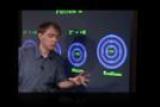Modern Chemistry
Chapter 3: Elements, Compounds, and Mixtures
Periodic Trends
Periodic trends are found with elements that have similar electron configurations, thus causing the elements to have similar physical and chemical properties. Graphics of the shell model are used to explain inner-shell shielding and effective nuclear charge. Duration: 7:00
Atomic Size
Using the concepts of inner shell shielding and effective nuclear charge, periodic trends such as atomic size are explained. Duration: 5:28.
Watch these additional videos to complete this tutorial.


